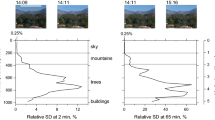Summary
The spectral reflectance of feathers was measured in the range between 310 and 730 nm by means of a diode array spectrometer. In many feathers an ultraviolet (UV) reflection adds to the reflection in the visible range which causes their coloration as seen by man. The UV reflectance is related to the presence of pigments in feathers and to the arrangement of structures which influence the light reflecting properties. Feathers giving strong UV reflection are called type A, without UV reflection type B, and giving weak to medium UV reflection type A/B. On the assumption that birds are tetrachromates, colour vision in birds and their possible chromaticity diagrams are discussed. If red, green, blue and UV are primary colours, three secondary colours are present in the daylight spectrum: yellow, blue-green, and violet-ultraviolet. Three more secondary hues may originate from mixing spectral lights: purple (red and violet), ‘bird's purple’ (red and UV), and ‘green purple’ (green and UV). Some feathers with double-banded reflectance curves will produce hues which are not present in the daylight spectrum.
Similar content being viewed by others
References
Bowmaker JK (in press) Avian colour vision and the environment. In: Proceedings of the 19th International Ornithological Congress, Ottawa
Burkhardt D (1982) Birds, berries and UV. A note on some consequences of UV vision in birds. Naturwissenschaften 69:153–157
Burkhardt D (1983) Wavelength perception and colour vision. In: Cosens DJ, Vince-Price D (eds) The biology of photoreception. Cambridge University Press, Cambridge, pp 371–397 (Society for Experimental Biology Symposia 36)
Burkhardt D (1988) Die Welt mit anderen Augen. Wie Insekten und Vögel die Welt und ihre Farben sehen. Aus Forschung und Medizin, Schering AG Berlin
Burkhardt D, Maier E (1989) The spectral sensitivity of a passerine bird is highest in the UV. Naturwissenschaften 76:82–83
Burrt EH jr (1986) An analysis of physical, and optical aspects of avian coloration with emphasis on wood-warblers. American Ornithologists Union, Washington DC, pp 1–126 (Ornithological Monographs no 38)
Chen D-M, Goldsmith TH (1986) Four spectral classes of cone in the retinas of birds. J Comp Physiol A 159:473–479
Chen D-M, Collins JS, Goldsmith TH (1984) The ultraviolet receptor of bird retinas. Science 225:337–340
Daumer K (1958) Blumenfarben, wie sie die Bienen sehen. Z Vergl Physiol 41:49–110
Dorst J (1974) The life of birds, vol I: The colours of birds. Weidenfeld and Nicolson, London, pp 48–59
Durrer H (1986) Colouration. In: Bereiter-Hahn J, Matoltsy AG, Richards KS (eds) Biology of the integument, vol 2, Chap V, The skin of birds, part 12. Springer, Berlin Heidelberg New York, pp 239–247
Durrer H, Villiger B (1966) Schillerfarben der Trogoniden. Eine elektronenmikroskopische Untersuchung. J Ornithol 107:1–26
Dyck J (1971) Structure and colour-production of the blue barbs ofAgopornis roseicollis andCotinga maynana. Z Zellforsch 115:17–29
Eisner T, Silberglied RE, Aneshansley D, Carrel JE, Howland HC (1969) Ultraviolet video-viewing: the television camera as an insect eye. Science 166:1172–1174
Emmerton J, Delius JD (1980) Wavelength discrimination in the visible and ultraviolet spectrum by pigeons. J Comp Physiol 141:47–52
Gerlinger H, Schlemmer H (1988) Simultanspektrometer für die Produktkontrolle. GIT Fachz Lab 32:167–170
Goldsmith TH, Collins JS, Perlman DL (1981) A wavelength discrimination function for the hummingbirdArchilochus alexandri. J Comp Physiol 143:103–110
Goldsmith TH, Collins JS, Licht S (1984) The cone oil droplets of avian retinas. Vision Res 24:1661–1671
Graf V, Norren DV (1974) A blue sensitive mechanism in the pigeon retina: λmax 400 nm. Vision Res 14:1203–1209
Huth H-H, Burkhardt D (1972) Der spektrale Sehbereich eines Violettohr-Kolibris. Naturwissenschaften 59:650
Jane SD, Bowmaker JK (1988) Tetrachromatic colour vision in the duck (Anas platyrhynchos L.): microspectrophotometry of visual pigments and oil droplets. J Comp Physiol A 162:225–235
Kreithen ML, Eisner T (1978) Ultraviolet light detection by the homing pigeon. Nature 272:347–348
Leibmann PA, Granda AM (1975) Super dense carotenoid spectra resolved in single cone oil droplets. Nature 253:370–372
Lutz FE (1924) Apparantly non-selective characters and combination of characters, including a study of ultraviolet in relation to the flower-visiting habits of insects. Ann NY Acad Sci 29:181–283
Menzel R (1987) Farbensehen blütenbesuchender Insekten. Internationales Büro der Kernforschungsanlage, Jülich
Meyer-Rochow VB, Eguchi E (1983) Flügelfarben, wie sie die Falter sehen — a study of UV and other colour patterns in Lepidoptera. Ann Zool Jpn 56:85–99
Munsell Book of Color (1976) Munsell Color Corporation, Baltimore
Needham AE (1974) The significance of zoochromes. Springer, Berlin Heidelberg New York
Neumeyer Ch (1988) Das Farbensehen des Goldfisches. Eine verhaltensphysiologische Analyse. Thieme, Stuttgart
Norren DV (1975) Research note. Two short wavelength sensitive cone systems in pigeon, chicken and daw. Vision Res 15:1164–1166
Schiemenz F (1924) Über den Farbensinn der Fische. Z Vergl Physiol 1:175–220
Schwind R (1985) Sehen unter und über Wasser, Sehen von Wasser. Das Sehsystem eines Wasserinsekts. Naturwissenschaften 72:343–352
Silberglied RE (1979) Communication in the ultraviolet. Annu Rev Ecol Syst 10:373–398
Vetter W, Englert G, Rigassi N, Schwieter U (1971) Spectroscopic methods. In: Isler O (ed) Carotenoids, IV. Birkhäuser, Basel, pp 189–266
Voitkevich AA (1966) The feathers and plumage of birds. Sidgwick and Jackson, London, pp 20–39
Wehner R (1987) ‘Matched filters’ — neural models of the external world. J Comp Physiol A 161:511–531
Wright AA (1972) The influence of ultraviolet radiation on the pigeon's colour discrimination. J Exp Anal Behav 17:325–337
Author information
Authors and Affiliations
Additional information
Dedicated to Johann Schwartzkopff on his 70th birthday
Rights and permissions
About this article
Cite this article
Burkhardt, D. UV vision: a bird's eye view of feathers. J. Comp. Physiol. 164, 787–796 (1989). https://doi.org/10.1007/BF00616750
Accepted:
Issue Date:
DOI: https://doi.org/10.1007/BF00616750




